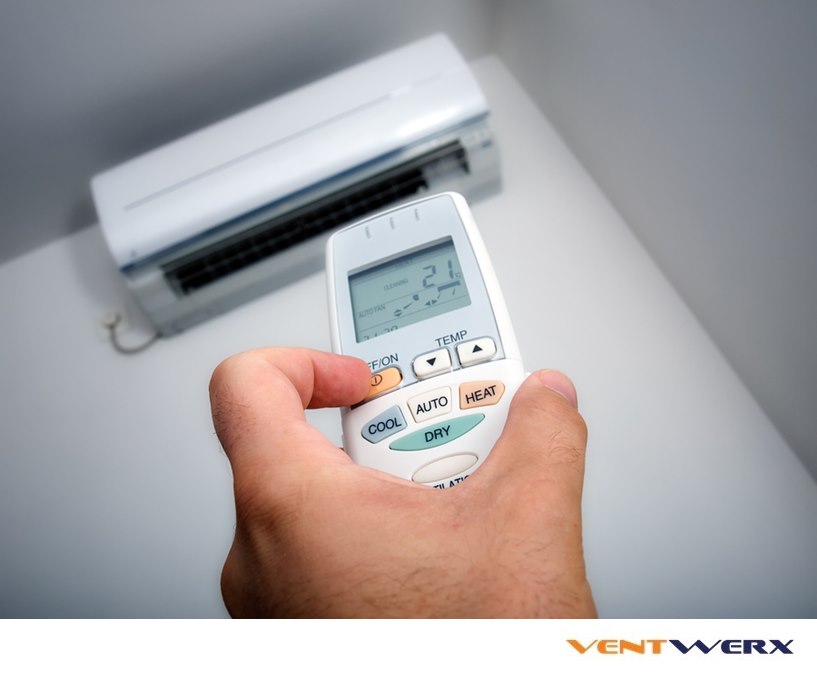When the weather is warmer in spring, summer, and early autumn, you may be wondering if your central air conditioning is running efficiently. Is the air coming out of the AC as cool as it is supposed to be?
Below, we look at what temperature the air blowing from your AC system should be, and how some components of your air conditioning work. Lastly, we’ll troubleshoot some common issues if the air appears to be blowing too hot, and possible fixes.
How Cold Should the Air Coming From Your Air Conditioner Be?
Air conditioners do not create “cold” air, they remove heat energy from existing air and recirculate it in an environment.
An ideal temperature differential between air coming into to be cooled, and the air being blown out is 14° to 20° F.
The temperature difference between return and supply air is known as the evaporator Delta T.
What Is Supply and Return Air?
When your central air conditioner is in cooling mode, warm air is pulled into large grilles placed strategically in the home. This is return air.
Return air runs along an evaporator coil, where heat energy is absorbed by refrigerant in the coil. This heat energy is exchanged in the outdoor condenser/compressor.
The now cooled air is blown through supply registers or vents, sometimes placed is the ceilings or walls of the home. This is supply air.
An easy way to remember which air is which: the air that has yet to be conditioned is returning to the heat exchanger or evaporator. The conditioned air is supplied to the home.
Measuring the Air Temperature Differential in Your Home AC System
To measure the differential temperature, or Delta T, of your air conditioning unit, first run the AC for at least fifteen minutes. Then, using an infrared thermometer, measure the temperature of the air coming from the supply register nearest the evaporator coil for five minutes. Next, measure the temperature of the air at an air return grille for five minutes. Last, subtract the supply air temperature from the return air temperature. This should be between 14 and 20 degrees Fahrenheit.
What if the Temperature Differential Isn’t Hitting the Target?
If you are seeing a different temperature gap on different supply vents, it is possible there is a leak or a blockage in your ductwork. When one or more vents are blowing warm air, but others are blowing cool air, it is likely that there is a rupture in the ductwork causing cool air to escape.
If all the supply vents are blowing air that is too warm, it could be a few different issues.
It is possible that you have dirty air filters that are causing inefficient cooling. Replace the filters and see if that solves the problem.
Another common issues is that the refrigerant is low. This facilitates the heat exchange, as heat energy is absorbed into the refrigerant, and dispersed outdoors. In the winter, this process works in reverse. These two issues are relatively easy to fix.
Now, it can also be possible that you have major leaks in your ductwork, in the attic, walls, or under the house—depending on how your ductwork was set up. If you have notice a sharp increase in your energy bills, that stays consistently high, this might be the root cause. This has the potential to be a more complicated fix.
One other possible culprit for warm air blowing from your AC might be a dirty evaporator coil. This is where heat is exchanged.
If you are unsure of why your air conditioner is working inefficiently, call a professional HVAC contractor.
How to Keep Your Home Cool in Warmer Months
If you keep in mind that your air conditioner will consistently push our air that is 14 to 20 degrees cooler than the air coming in, you can strategize how to keep your home cool when the mornings and afternoons are warm.
It is easiest to keep the temperature in a comfortable range instead of trying to quickly decrease the temperature in the middle of the day. First, use shading and other techniques to keep the air inside your home cool. Here are some ideas for keeping your home cool without AC.
Next, if you are using a smart thermometer, keep the “away” temperature within 5 degrees of your target temperature. It will take about an hour for your AC system to hit the target temperature when you get home. Moving the thermostat to a lower temperature when you get home from in the evening doesn’t make the air conditioner cool the home any faster. The air coming in the return vents still has to remove heat, and the cooler air must circulate through the supply registers in the rooms of your home.
If You Need Help With AC Repair in the South Bay / San Jose
Ventwerx HVAC can help homeowners AC repair, air duct cleaning and inspection, ductless HVAC, and any other residential AC repair. We serve the San Jose area, as well as Morgan Hill and Gilroy. We are licensed and bonded, and have served the South Bay and Central Coast since 2007.
If you need air conditioning repair or AC replacement, fill out a service request, or call (408) 422-2987 in San Jose or (408) 710-9595 in Morgan Hill.
Whether you require installation, repair, or maintenance, our technicians will assist you with top-quality service at any time of the day or night. Take comfort in knowing your indoor air quality is the best it can be with MOE heating & cooling services Ontario's solution for heating, air conditioning, and ventilation that’s cooler than the rest.
Contact us to schedule a visit. Our qualified team of technicians, are always ready to help you and guide you for heating and cooling issues. Weather you want to replace an old furnace or install a brand new air conditioner, we are here to help you. Our main office is at Kitchener but we can service most of Ontario's cities
Source link




Add Comment